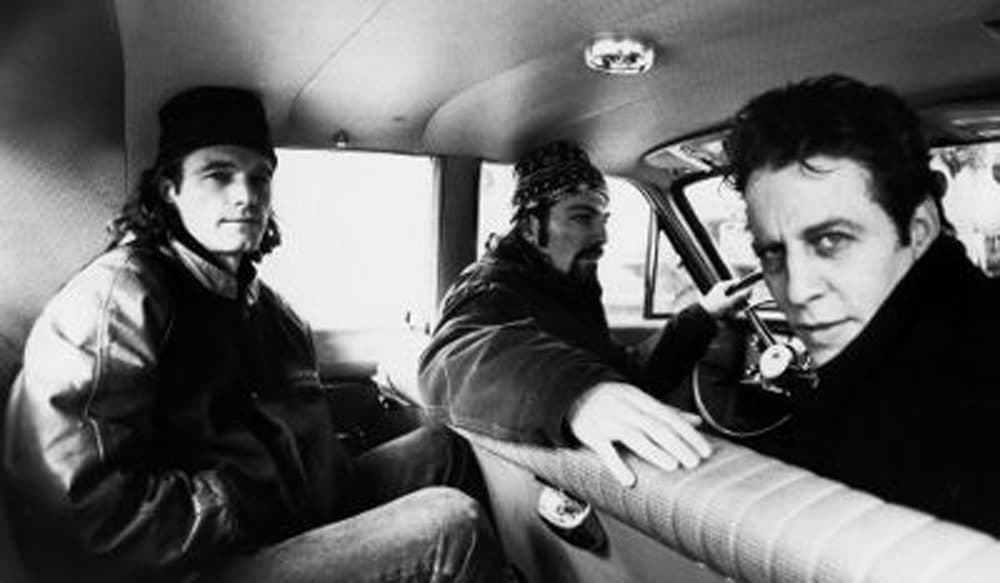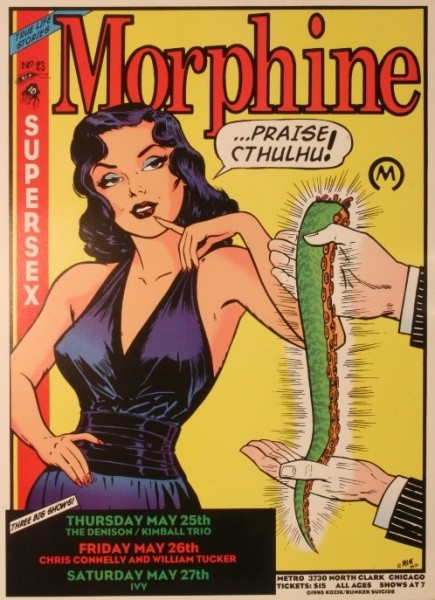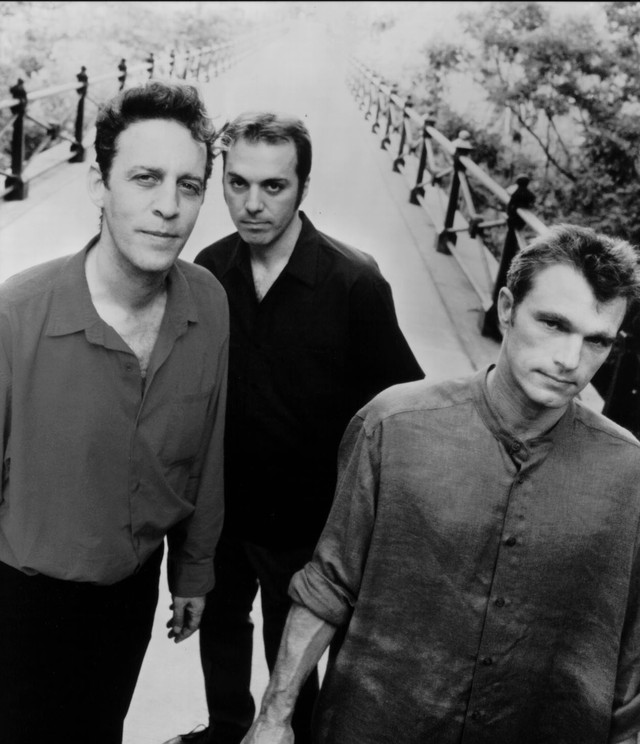Morphine

Morphine frontman Mark Sandman once called the group “a casual experiment that went out of control.” The band started as a side project that simmered in the background while the trio of Sandman, Jerome “Jerry” Deupree and Dana Colley were playing in other Boston-based bands (Treat Her Right, The Sex Execs and Three Colors), but morphed into one of the hottest acts on the Boston scene and one of the most critically acclaimed, both nationally and internationally.
Wanting to create a sound contrary to the fast, over-packed music of the late ‘80s, Sandman, Deupree and Colley decided to keep things simple when they formed Morphine in 1989, using a homemade bass with two strings, a basic jazz kit and baritone sax – no guitars, no keyboards. In their opinion, the mainstream bands of the era flooded the zone with guitars and keyboards, added drum effects that didn’t sound drum-like at times and filled their songs with far too many notes. Morphine, on the other hand, took a bare-bones approach, wanting listeners to hear the purity of the instruments and the soulfulness of the songs. In a 1995 review for The Washington Post, Geoffrey Himes noted that the band’s sound was unique at the time. “In a rock ‘n’ roll world divided between guitar bands and synth bands, Morphine exists in a no-man’s zone,” he wrote. The band’s manager, Deb Klein, said they played a low, smokey, nocturnal sort of music that made you want to either move your hips or have sex.
INSPIRATION, INSTRUMENTATION
Sandman’s early inspiration for the two-string base came from the 1956 song “Cherokee Dance” on which Bob “Froggy” Landers played the Unitar, a one-string electric guitar heard in the Delta blues of the ‘30s and ‘40s. Add the silky sound of the baritone sax, the jazz kit and Sandman’s baritone vocals and you have something truly different. Though saxophonist Colley wondered if the concept was too experimental to draw crowds, the trio pressed on and Sandman constantly wrote new material while trying different chords/pickups and rearranging lyrics until he thought they fit the song best. His “tri-tar” evolved using one bass string and two guitar strings with a slide and his homemade two-string base (originally a single-string) with a slide became one of Morphine’s signature sounds; critics called the sound “low guitar.”
Baritone saxophonist Colley was so skilled that he could play two saxophones at once; he cites a major influence as jazz great Rahsaan Roland Kirk, who was known for playing three at once. Deupree, a drum purist, didn’t want the “un-drum-like” sound full of different effects that filled most other stages. He wanted the drum to sound like, well, like a drum (imagine that!). Deupree left the band in 1993, replaced by Billy Conway, who remained with the group for the rest of its existence. Sandman said his lyrical inspiration drew from relationships, addiction and/or words and phrases that resonated with him. Sometimes they were simple things that stuck in his head, he said, noting that the song “Top Floor, Bottom Buzzer” is based on his apartment building in Cambridge. A broken door buzzer wouldn’t inspire most songwriters, but the band included it on their album The Night (2000), which peaked at #137 in the Billboard 200.
CAMBRIDGE ROOTS, THE MIDDLE EAST, ALBUMS
Above all, Morphine considered themselves a Cambridge band, not a Boston one, which is an important distinction; for many Bostonians, Cambridge is almost like another country. The band made their home base at The Middle East in Central Square which, to provide some context, was not a trendy or touristy area in the late ‘80s and early ‘90s. Rents were cheap and you could park a car for less than a dollar, so it was a haven for students and musicians. Morphine played their first gig at the venue in 1990 (several months before becoming an official band), taking the stage without a name and intending to play that one show only. “The first gigs were fun,” Deupree says. “We played some cover songs by Mose Allison. We knew we were a different sound from the other Boston bands.” Though many assume the band named themselves Morphine as a reference to the drug, the name refers to the Greek god Morpheus, the god of sleep and dreams.
Boston College radio station WZBC was the first to air Morphine, playing their demo tape in regular rotation in late 1989. Though the exposure was a big help, it wasn’t enough to promote the band adequately so, using their limited resources, the band produced marketing cassettes with Xeroxed labels and handed them out by the hundreds. The trio brought their first demo tape to Q Division Studios in Boston and, as Sandman recalls, as soon as the song “Bueno” played, studio employees flocked to the control room asking, “What the fuck is THAT?”, which proved that they were onto something. Accurate/Distortion released Morphine’s debut album, Good, in 1992 (reissued by Rykodisc in 1993), and four more followed: Cure for Pain (1993, Rykodisc), Yes (1995, Rykodisc), Like Swimming (1997, DreamWorks/Rykodisc) and The Night (2000, DreamWorks). According to Nielsen SoundScan data, over 805,000 copies of the records had sold in the United States.
TOURING, SANDMAN’S DEATH, COMPILATIONS, DOCUMENTARIES
While other bands ached to open for headliners in larger venues, Morphine chose to do live shows where they weren’t warming up for someone; they wanted the show to be about them. They did brief tours on the West Coast and they played colleges around the country, some with as few as 10 people in the audience for as little as $75. They were able to build a sizable fan base and by 1993, they were doing shows and appearing at festivals all over the world. At one festival in Europe, The Clash’s Joe Strummer grabbed Mark and said “Hey! You’re that guy from Morphine!”
In July 1999, during a European tour, band members noticed Sandman moving more slowly than usual the day before a show in Palestrina, Italy. By showtime, however, he seemed to have renewed energy, and he’d practiced what he wanted to say to the audience in Italian so that the band could connect. The group had a great start, but Sandman began playing very differently on the seventh song, then his knees buckled and he fell backward. There was a scramble to help but ultimately silence. In the hospital, the band watched as the sheet was pulled over his face. He’d died of a heart attack at age 46. Naturally, with a name like Morphine, the police thought it was drug-related, which was simply not true. The band played a second concert in Palestrina the very next day, on the same stage with the same instruments. Following the show, the mayor of Palestrina dedicated the steps leading to the venue to Sandman.
Today, if you walk out the door of The Middle East, take a few steps and look up, you’ll see a sign on the corner of Mass. Ave. and Brookline Street: Mark Sandman Square. That’s where the Morphine story started, where they first took the stage together and where Sandman watched bands, listened and took notes. In 2009, Colley, Deupree and Conway formed the band Vapors of Morphine in Palestrina to perform a tribute to Sandman, and the group played around the world and at their home base, The Middle East, through 2023.
Rykodisc has issued two compilations of Morphine’s material, B-Sides and Otherwise (1997) and The Best of Morphine: 1992-1995 (2003), and in 2004 Hi-N-Dry released the two-CD, one-DVD set Sandbox: The Music of Mark Sandman. Documentaries include Cure for Pain: The Mark Sandman Story (2011) and Morphine: Journey of Dreams (2014).
(by Jeff Booth)















